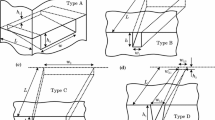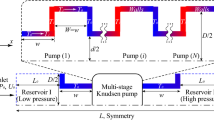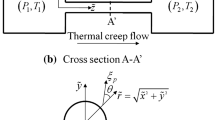Abstract
Moderately rarefied gas flows are clearly distinguished from viscous flow in the continuum regime and from free molecular flow at high rarefaction. Being of relevance for various technical applications, the understanding of such flow processes is crucial for considerable enhancement in micro electromechanical systems (MEMS) and vacuum techniques. In this work, we focus on the isothermal rarefied gas flow through long channels with longitudinally varying cross section. We apply two approaches, an analytical one and a numerical one that is based on the solution of the linearized S-model, both allowing us to predict the mass flow rate in diverging and converging flow directions for arbitrary pressure gradients. Both approaches are validated by CO2, N2 and Ar permeation experiments on tapered microchannels manufactured by means of micromilling. The local Knudsen numbers ranged from 0.0471 to 0.2263. All the numerical and analytical results are in good agreement to the experimental data and show that the mass flow rate is significantly higher when the duct is perfused in converging direction. The understanding of the physical phenomenon of this gas flow diode effect might pave the way for novel components in MEMS such as static one-way valves.





Similar content being viewed by others
References
Albertoni S, Cercignani C, Gotusso L (1963) Numerical evaluation of the slip coefficient. Phys Fluids 6:993
Aubert C, Colin S (2001) High-order boundary conditions for gaseous flows in rectangular microducts. Microscale Therm Eng 5:41–54
Aubert C, Colin S, Caen R (1998) Unsteady gaseous flows in tapered microchannels. In: Technical proceedings of the 1998 international conference on modeling and simulation of microsystems, volume chapter 11: applications: microfluidics, pp 486–491
Bird GA (1994) Molecular gas dynamics and the direct simulation of gas flows. Oxford Science Publications, Oxford University Press Inc., New York
Colin S, Lalonde P, Caen R (2004) Validation of a second-order slip flow model in a rectangular microchannel. Heat Transf Eng 25:23–30
de Silva LR, Deschamps CJ (2012) Modeling of gas leakage through compressor valves. In: International compressor engineering conference, paper 2105
Ewart T, Perrier P, Graur IA, Méolans JG (2007) Mass flow rate measurements in microchannel, from hydrodynamic to near free molecular regimes. J Fluid Mech 584:337–356
Graur IA, Perrier P, Ghozlani W, Méolans JG (2009) Measurements of tangential momentum accommodation coefficient for various gases in plane microchannel. Phys Fluids 21:102004
Graur I, Ho MT (2014) Rarefied gas flow through a long rectangular channel of variable cross section. Vacuum 101:328–332
Lee HW, Azid HA (2009) Neuro-genetic optimization of the diffuser elements for applications in a valveless diaphragm micropumps system. Sensors 9:7481–7497
Ohwada T, Sone Y, Aoki K (1989) Numerical analysis of the shear and thermal creep flows of a rarefied gas over a plane wall on the basis of the linearized Boltzmann equation for hard-sphere molecules. Phys Fluids A 1:1588–1599
Perrier P, Graur IA, Ewart T, Méolans JG (2011) Mass flow rate measurements in microtubes: from hydrodynamic to near free molecular regime. Phys Fluids 23:042004
Porodnov BT, Suetin PE, Borisov SF, Akinshin VD (1974) Experimental investigation of rarefied gas flow in different channels. J Fluid Mech 64:417–437
Sharipov F, Seleznev V (1998) Data on internal rarefied gas flows. J Phys Chem Ref Data 27:657–706
Sharipov F (1999) Non-isothermal gas flow through rectangular microchannels. J Micromech Microeng 9:394–401
Sharipov F, Bertoldo G (2005) Rarefied gas flow through a long tube of variable radius. J Vac Sci Technol A 23:531–533
Siewert CE, Sharipov F (2002) Model equations in rarefied gas dynamics: viscous-slip and thermal-slip coefficients. Phys Fluids 14:4123–4129
Stemme E, Stemme G (1993) Valve-less diffuser/nozzle based fluid pump. Sens Actuators A Phys 39:159–167
Stevanovic ND (2007) A new analytical solution of microchannel gas flow. J Micromech Microeng 17:1695–1702
Stevanovic ND, Djordjevic VD (2012) The exact analytical solution for the gas lubricated bearing in the slip and continuum flow regime. Publications de l’Institut Mathématique 91:83–93
Titarev VA, Utyuzhnikov SV, Shakhov EM (2013) Rarefied gas flow into vacuum through square pipe with variable cross section. Comput Math Math Phys 53:1221–1230
Veltzke T (2013) On gaseous microflows under isothermal conditions. PhD thesis, University of Bremen
Veltzke T, Baune M, Thöming J (2012) The contribution of diffusion to gas microflow: an experimental study. Phys Fluids 24:082004
Acknowledgments
Some of the presented results are based on a project funded by German Federal Ministry of Economics and Technology (BMWi) according to a decision of the German Federal Parliament; funding code 0327512A. One of the authors (Thomas Veltzke) wants to thank Georg Grathwohl for his support.
Author information
Authors and Affiliations
Corresponding author
Appendix
Appendix
See Tables 2, 3, 4, 5, 6, 7, 8, 9 and 10.
Rights and permissions
About this article
Cite this article
Graur, I., Veltzke, T., Méolans, J.G. et al. The gas flow diode effect: theoretical and experimental analysis of moderately rarefied gas flows through a microchannel with varying cross section. Microfluid Nanofluid 18, 391–402 (2015). https://doi.org/10.1007/s10404-014-1445-4
Received:
Accepted:
Published:
Issue Date:
DOI: https://doi.org/10.1007/s10404-014-1445-4




